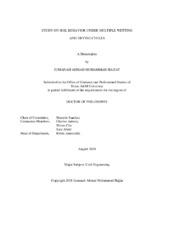| dc.contributor.advisor | Sanchez, Marcelo | |
| dc.creator | Hajjat, Jumanah Ahmad Mohammad | |
| dc.date.accessioned | 2019-01-18T14:51:43Z | |
| dc.date.available | 2020-08-01T06:36:49Z | |
| dc.date.created | 2018-08 | |
| dc.date.issued | 2018-07-31 | |
| dc.date.submitted | August 2018 | |
| dc.identifier.uri | https://hdl.handle.net/1969.1/173979 | |
| dc.description.abstract | During thermal seasonal variations, expansive soils may exhibit increase in volume upon wetting (swell) and decrease in volume during drying (shrinkage). In this regard, it is essential to understand the variations in hydro-mechanical behavior of soils during wetting/drying cycles for evaluating the stability and sustainability of natural soils and engineering structures as well.
Crack formation is a widespread natural phenomenon raised during evaporation process of water from fully or partially-saturated soils during dry seasons. Fundamental to understanding crack development in soils is twofold; first to determine the tensile strength under circumstances mimicking those in the field and second to track the motion of soil particles during multiple wetting and drying cycles. In most of the previous studies, the tensile strength was measured when external applied tensile loads produced failure in a soil tested under constant water content and matric suction. However, very little attention has been directed to study the impact of wetting/drying cycles on tensile strength incorporated with the evolution and propagation of cracks.
The research herein has stemmed from the observation of crack propagation in some geotechnical structures when soils undergo successive drying and wetting cycles. Accordingly, this study was motivated by the assumption that crack propagation is owing to the decrease in tensile strength of soil over cycles. A novel approach was employed using a new innovative device for measuring the tensile strength of the soil subjected to multiple wetting/drying cycles similar to the field conditions. The determination of tensile strength was incorporated with tracking the motion of soil particles during cycles by utilizing the Digital Image Correlation (DIC) technique.
The reduction of tensile strength was determined, and crack propagation was quantitively described and analyzed over cycles.
The influences of soil interfaces and initial saturation conditions on shear strength and crack behavior of soil were also studied. It was revealed through this research that crack formation in soil is strongly related to the variations in the configurations of soil particles and stress state that occur during alternative shrinkage and swelling when exposed to drying and wetting, respectively. The findings generated by this study can be used to improve our understanding of crack mechanism in soils during cyclic wetting/drying processes. | en |
| dc.format.mimetype | application/pdf | |
| dc.language.iso | en | |
| dc.subject | Tensile strength | en |
| dc.subject | desiccation crack | en |
| dc.subject | cycles | en |
| dc.title | STUDY ON SOIL BEHAVIOR UNDER MULTIPLE WETTING AND DRYING CYCLES | en |
| dc.type | Thesis | en |
| thesis.degree.department | Civil Engineering | en |
| thesis.degree.discipline | Civil Engineering | en |
| thesis.degree.grantor | Texas A & M University | en |
| thesis.degree.name | Doctor of Philosophy | en |
| thesis.degree.level | Doctoral | en |
| dc.contributor.committeeMember | Aubeny, Charles | |
| dc.contributor.committeeMember | Cha, Minsu | |
| dc.contributor.committeeMember | Abedi, Sara | |
| dc.type.material | text | en |
| dc.date.updated | 2019-01-18T14:51:43Z | |
| local.embargo.terms | 2020-08-01 | |
| local.etdauthor.orcid | 0000-0003-0867-9188 | |


